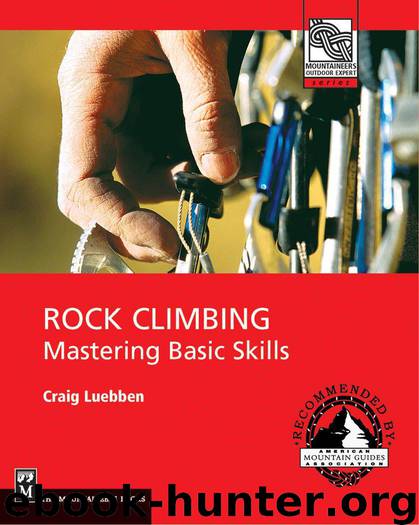Rock Climbing: Mastering Basic Skills (Mountaineering Outdoor Experts Series) by Luebben Craig

Author:Luebben, Craig [Luebben, Craig]
Language: eng
Format: mobi
Publisher: Mountaineers Books
Published: 2011-02-28T23:00:00+00:00
WORKING A ROUTE
If you can’t send a route foundational skills fosC Jeremy Collins”it on the first try, you can always work it, practicing the moves and clips while hanging liberally on the rope to avoid getting too pumped. The idea is to learn the moves then go for the redpoint, linking the entire route without hanging on the rope. If a route is obviously beyond your onsight ability, you may choose to work it without even attempting an onsight or flash, just to save energy. Don’t always focus on routes that require tons of work to send, though, or you may lose the flow and be forced into a choppy climbing style.
On your first attempt of a route, you might make a “test run,” to preview the moves, hang the quickdraws, and see if you’re even interested in working on the route. In a sense, you’re interviewing the route to see if it offers what you want to keep you interested through a few tries, or even a few days or weeks of working the moves. On this test run you’ll rest liberally on the rope, exploring holds and different options for making the moves.
Once you’ve decided to make the route a project, your job is to learn and practice the moves and sequences so you can efficiently link them in one push from the ground. One of the quickest ways to learn the moves is to seek beta from other climbers, both by asking them directly and by watching them on the route. It’s best to get beta from climbers similar to you in size and climbing style; otherwise, you may get tips that don’t work for you. Even if another climber is your size and has a similar style, his beta may not be well suited for you; stay open-minded and seek the best solutions. It can be helpful to get a “cheering” section going, a group of friends on the ground who will encourage you and feed you beta when you get stifled. This positive energy infusion can be a great boost on hard routes. Some climbers prefer silence, though, so know your partner’s preference.
After the test run, you can choose your strategy for working the route. Perhaps you now have enough knowledge to “send” the route next try. Or maybe you need a few more runs, or a few days working the route to learn the sequences and increase your efficiency. In this case, break the climb into different sections and practice the moves, especially the cruxes, and rest on the rope between sections. Once you’ve figured out all the sections, practice the transitions between sections to put the whole thing together. Once you feel you can link all the moves from the ground to the top, it’s time for a redpoint attempt.
THE REDPOINT
An important redpoint starts the day (or days) before you head to the crag. If you’ve worked the moves extensively, “visualize” the entire sequences a few times each day before you head out for the redpoint.
Download
This site does not store any files on its server. We only index and link to content provided by other sites. Please contact the content providers to delete copyright contents if any and email us, we'll remove relevant links or contents immediately.
| Excursion Guides | Mountain Climbing |
| Rock Climbing |
Annapurna by Maurice Herzog(3422)
Into Thin Air by Jon Krakauer(3308)
SAS Survival Handbook by John 'Lofty' Wiseman(2671)
The Ogre by Doug Scott(2631)
Everest the Cruel Way by Joe Tasker(2278)
Reservoir 13 by Jon McGregor(2240)
The End of Eddy by Édouard Louis(2155)
Touching the Void by Joe Simpson(2090)
The Push by Tommy Caldwell(2002)
Iced In by Chris Turney(1958)
The Isle of Mull by Terry Marsh(1893)
The Call of Everest by Conrad Anker(1865)
Miracle in the Andes by Nando Parrado(1862)
Touching the Void (1987) by Joe Simpson(1800)
Mud, Sweat, and Tears by Bear Grylls(1614)
Himalaya Bound by Michael Benanav(1571)
Higher Calling by Max Leonard(1540)
Death Grip by Matt Samet(1444)
Backcountry Bear Basics by Dave Smith(1433)
